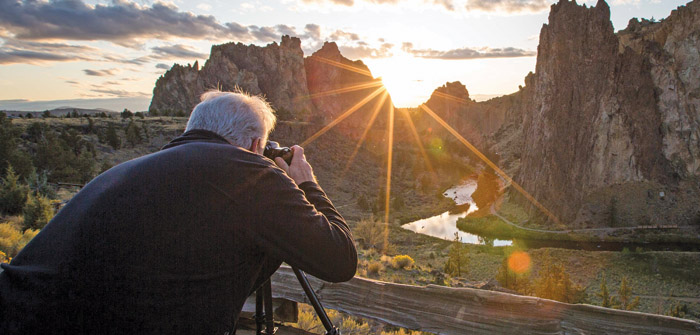(Photo Courtesy of Bend Photo Tours)
It’s no secret that Bend is a tourist destination; many people who now call this city home were once eager-eyed visitors, seeing the Three Sisters and the Cascade Range for the first time. As a city so affected by travel, tourism in Central Oregon is a massive economic driver with effects that reach into many other related industries, from hotels and lodging to recreational activities, dining, the nonprofit realm and more.
By the Numbers
The City of Bend Dean Runyan Report, produced by Dean Runyan Associates and provided by Visit Bend, shows the nitty-gritty of tourism’s economic impact on Bend. According to the report, “The Oregon travel economy reached new highs across most categories in 2022. Continued demand for overnight accommodations and increased price inflation led to large gains in visitor spending. This increased spending and a tight labor market contributed to an increase in employee earnings, with both having a cumulative effect on increased tax revenue. Employment has recovered to 99 percent of peak employment reached in 2019.”
The report also stated that travel spending in Bend increased by 13.6 percent, from $336.3 million in 2021 to $382.2 million in 202. The total number of travel-generated jobs grew by 10 percent since 2021, reaching 3,120, and travel-generated earnings increased to $101.5 million, a gain of 20.9 percent, from 2021.
As a region, Central Oregon does not have an abnormally large share of tourism in Oregon; most tourism in the state occurs along the I-5 corridor. The Portland area accounts for 37 percent of Oregon’s travel spending, while the Willamette Valley makes up 18 percent, Southern Oregon makes up 10 percent, and Central Oregon makes up 9 percent.
Despite Central Oregon not being the state’s hotspot for travel spending, Bend still makes up a massive portion for the region. In Central Oregon, Bend claims 32 percent of all the direct travel spending, while amassing 53 percent of the revenue.
Giving Back
There is some concern among Bendites and those involved in the tourism industry that the rising cost of living has begun to affect tourism dollars. Afterall, when gas, rent and groceries all go up, many people’s budgets no longer include much time or money for travel. While there is some truth to this concern that we might see in next year’s Dean Runyan Report, the numbers from 2021 to 2022 look promising; during that time period, annual spending on accommodations grew from $145 million to $162 million, while spending on other travel related goods followed a similar trend.
While many are excited by Bend’s popularity, many feel the opposite; that tourism exists only for the tourists and locals get left behind in more ways than one. CEO of Visit Bend Kevney Dugan says that this concern is a very real one that he hears often, and takes very seriously. He spoke a bit about how when he first started with Visit Bend as the director of sales in 2010, the goals of the organization and the entire tourism industry were different. “In 2010, the community was still reeling from an economic crash,” Dugan said. “For the first five years or so of my time here, the main goal was to get the local economy back on its feet.”
Dugan continued, saying that, “What sets Visit Bend apart is that back in 2016, we recognized our impact on the community and we adjusted that game plan. While most DMOs focused solely on their economic impact on the community, we knew that we needed a much broader perspective.”
That “much broader perspective” is one that aims to include locals, service industry workers, the housing market, the cost of living, the environment and in general, the Bend community as a whole. “Bend needs a thriving tourism industry, but that means we need a healthy and sustainable environment and economy,” Dugan said. “That’s what sets us apart.”
This approach can be summed up in three parts: economy, people and place. According to Visit Bend, keeping these three pillars healthy and equal to each other will help Bend remain an ethical and sustainable tourist destination for years to come, with a tourism industry that benefits all of us.
One of the biggest ways that tourism gives back to the community is the Transient Room Tax (TRT) that exists in Bend, and statewide. According to Visit Bend, “Anyone staying in a Bend hotel, vacation rental, or other short-term lodging pays a 10.4 percent tax to the City of Bend. Of the 10.4 percent hotel tax collected by the City of Bend, Visit Bend receives 31.2 percent that’s earmarked for marketing our destination to potential visitors. The City uses the remainder of the tax money (68.8 percent) for its General Fund as well as Public Safety, which includes police and fire. In fiscal year 2018/2019, the City retained $6,999,471 from TRT revenue.”
This means that tourism is quite literally funding the public works and services that keep Bend running. According to Dugan, Bend actually sits in a unique position, in regard to the TRT, “We have one of the most advantageous splits of TRT in the state, with two-thirds going to the city, and one-third going to tourism,” Dugan said. “Most places in Oregon are the opposite split, meaning that the amount that Bend retains from TRT as a percentage is significantly higher than most other cities in Oregon.”
Aside from the TRT revenue, Visit Bend has another way to give back to the community. The Bend Sustainability Fund is a project from Visit Bend that invests tourism dollars back into projects that will improve and maintain the city and surrounding areas. For example, $245,000 was granted to local nonprofit Discover Your Forest to expand and maintain a massive summer trail network on Mt. Bachelor, and $142,565 was granted to the Upper Deschutes Watershed Council for a restoration project along the Deschutes River.
These examples are just a few. Another Visit Bend fund, the Bend Cultural Tourism Fund, has granted funds to Bend Film Inc., The Downtown Bend Business Association, the High Desert Museum, the Old Mill District, OUT Central Oregon, the Central Oregon Center for the Arts and many more.
According to Dugan, these funds are a way to give back and support the communities, businesses and people who make the tourism industry possible.
From the Tour Guides
While the tourism industry might feel like an invincible one, the owners of some of Bends tour companies say that recents times have been more up and down, economically speaking. Mike Willock, owner of tour company Outriders NW, said that this last spring was a particularly slow season, but summer bookings have picked back up.
“It’s been a tough spring. I keep a close eye on transient tax dollars and it’s been down this year, Willock said. “That directly impacts bookings, and we’ve gotten way fewer bookings than this last spring,”
Willock said this drop was felt across the industry, but also said that the summer boom is also industry-wide, “All of a sudden, summer hits and bookings are back to normal numbers, which is consistent for many industries based on tourism,” Willock said. “We got low spring break numbers across the board, but things are coming back up in June and it’s projected to be a good summer.”
For Willock, success has been found in understanding trends in tourism. He said that Outriders NW began as a tour company that offers much longer offroading adventures — anywhere from 4 to 6 hours on the trails — but in recent years, he learned that many tourists to Bend are looking for that “sweet spot” between adventure and leisure.
“Outriders was able to grow by finding a sweet spot for our customers. We find that people generally enjoy starting with a shorter ride so that they can have the energy to follow through with afternoon and evening plans like concerts, floating the river and brewery hopping,” Willock said. “By reducing the time most people are on the trails, we increase their ability to experience other things on their vacation while still getting the experience they came to us for.”
Willock continued to say that most tourists are looking for that experience; to be able to go home to their friends or even post on social media about the cool thing they did, like take an ATV on an off road adventure. Afterall, why book a six hour tour when the pictures you take of a two hour tour look exactly the same?
This aspect of providing an experience, especially an Instagramable one, is paramount in the modern tourism industry, especially in a place as visually stunning as Central Oregon. Toni Toreno, owner of Bend Photo Tours, knows this better than most.
By offering guided tours for professional photographers and those looking to learn expert level photography skills, Toreno is very familiar with the notion that many tourists are looking for ways to share their experience with other people; photography, especially across social media, happens to be one of the most popular ways to do just that.
Aside from just sharing stories with friends, Toreno said that tour companies and the tourism industry in Bend definitely benefits from social media, “The industry 100 percent utilizes the power of good photography,” she said. “Bend is such a visual destination, it creates an influx of photographers of all levels. It’s people like this who end up taking the photos that get shared and influence other people to come visit. Bend is a trendy place on Instagram, and that’s a major selling point of my business.”
For guides like Willock and Toreno, the prevalence of social media has affected the way they do business in some way. For tourists, social media is a great way to find your next destination. However, social media is a double-edged sword that has increased the environmental impact of tourism on our public lands and natural amenities.
For guides like Toreno who are very aware of the impacts of social media, there is an urge to take up responsibility and educate clients on the environmental principle of leave-no-trace.
“We work a lot with nonprofits like Discover Your Forest and Visit Bend to make sure that we are engaging in this industry in sustainable ways,” Toreno said. “As tour guides, we have our own responsibility to teach those things to the public and the people who come on our tours. We live here and we love where we live, so we want to sustain all of that. In our role as a guide or educator, I definitely feel like we need to educate our clients on sustainable practices.”
While the recent history of tourism in Bend has seen its ups and downs (not to mention controversy), it does seem that the future of tourism in the region is bright. Very real steps have been taken by some of the industry’s biggest players to ensure that tourism going forward is sustainable for the industry, the greater community and the environment that we all depend upon.
In Dugan’s words, “We all genuinely love this place, and we believe that if we invest in and support the community and the environment, the industry will thrive.”



